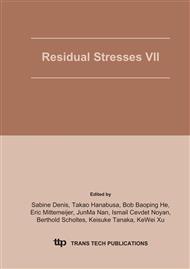p.67
p.73
p.79
p.85
p.91
p.97
p.102
p.107
p.112
Determination of Residual Stress Distribution in Autofrettaged Tube Based on Modified Yielding Criterion and Tensile-Compressive Curve of Material
Abstract:
An autofrettage model considering the material strain-hardening behavior and the Bauschinger effect, based on the actual tensile–compressive curve of material and modified yield criterion, has been proposed. The analytic expressions of residual stress distribution and the autofrettage pressure have been obtained. This model has stronger curve fitting ability, nearly all of the strain-stress curves of materials used in making autoefrettage tubes can be fitted well by this model, and each of those models based on the simplified strain hardening relationship of material is a special case of the model. It was used to predict the residual stress distributions of an autofrettaged tube. The results show that the residual stress distributions predicted by the present model are in good agreement with the experimental data.
Info:
Periodical:
Pages:
91-96
Citation:
Online since:
July 2005
Authors:
Price:
Сopyright:
© 2005 Trans Tech Publications Ltd. All Rights Reserved
Share:
Citation:


